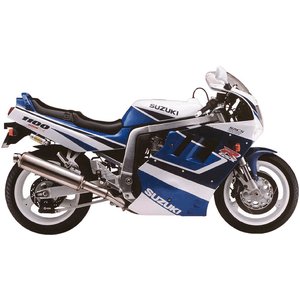Suzuki GSX-R 1100 [1989–1992]: A Thunderous Legacy of ’90s Sportbike Dominance
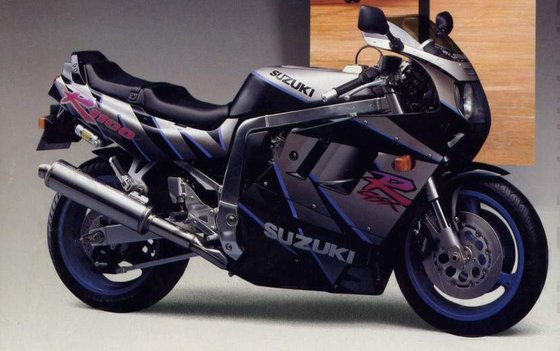
Introduction
The Suzuki GSX-R 1100 is a motorcycle that needs no introduction to enthusiasts of vintage sportbikes. Produced from 1989 to 1992, this generation of the GSX-R 1100 solidified Suzuki’s reputation as a powerhouse in the hyper-sport segment. With its gargantuan 1,127cc inline-four engine, race-bred chassis, and unmistakable ’90s styling, this bike was engineered to dominate both street and track. Having spent time aboard a meticulously maintained 1991 model, I can confirm: the GSX-R 1100 isn’t just a relic—it’s a visceral, unapologetic thrill machine that still commands respect today.
Design & Ergonomics: Form Follows Function (Mostly)

The GSX-R 1100’s design screams early-’90s aggression. The full fairing—adorned with Suzuki’s iconic blue-and-white livery or stealthy black—wraps around a twin-headlight front end, while the aluminum alloy frame hints at its lightweight ambitions (for the era). At 810 mm (31.9 inches), the seat height feels tall for shorter riders, but the wide, padded seat and slightly raised clip-ons (mounted above the triple clamp) strike a balance between sporty posture and all-day usability.
Passengers get a generous grab rail, but let’s be honest: this bike was built for solo rides. The windscreen offers minimal wind protection, directing airflow squarely at the rider’s chest—a reminder that aerodynamics were secondary to raw speed.
Engine Performance: The Heart of a Titan
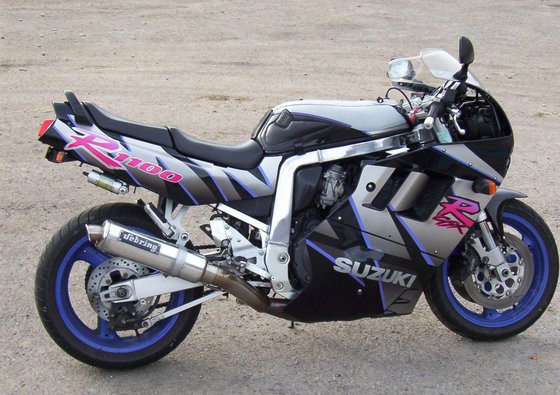
Key Specs:
- Engine: 1,127cc inline-four, DOHC, air/oil-cooled
- Power: 143 HP (104 kW) @ 9,500 RPM (full-power models)
- Torque: 117 Nm (86 lb-ft) @ 8,000 RPM
- Top Speed: 269 km/h (167 mph)
Fire up the GSX-R 1100, and the engine roars to life with a deep, metallic growl that’s music to any gearhead’s ears. The 40mm Mikuni flatslide carburetors (upgraded from 36mm in 1991) deliver crisp throttle response, while the midrange torque feels like a freight train. Roll on the throttle at 5,500 RPM, and the bike surges forward with relentless force, pulling hard until the 10,500 RPM redline.
The 5-speed gearbox is robust but requires deliberate shifts—this isn’t a flickable modern quickshifter. Clutch engagement is heavy, demanding forearm strength in traffic, but it’s a small price to pay for the raw power on tap.
Handling & Braking: A Contradiction of Confidence and Weight

Chassis Highlights:
- Front Suspension: 43mm Kayaba USD forks, fully adjustable
- Rear Suspension: Full-floater shock, 19-way damping adjustment
- Wheels/Tires: 17-inch Enkei alloys; 120/70 front, 180/55 rear
- Brakes: Dual 310mm front discs (4-piston calipers), single 240mm rear
Weighing in at 240 kg (529 lbs) wet, the GSX-R 1100 isn’t light by modern standards. Yet, the aluminum frame and fully adjustable suspension allow it to carve corners with surprising agility. At low speeds, the bike feels top-heavy, but once leaned over, it holds a line with stability.
The front brakes lack the bite of modern radial setups, and lever fade occurs during aggressive riding. Still, the Nissin calipers provide ample stopping power for street use. Swap the original rubber for modern radial tires (available at MOTOPARTS.store), and the grip transforms this ’90s beast into a cornering machine.
Competition: How the GSX-R 1100 Stacks Up
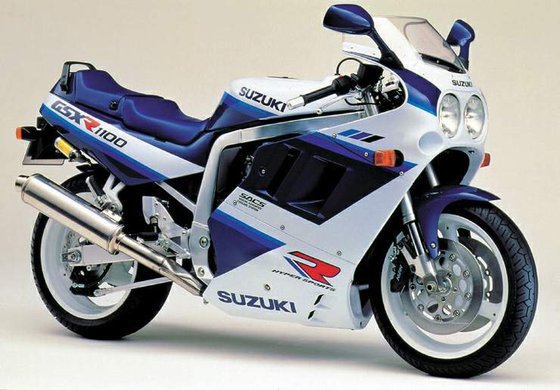
Yamaha FZR 1000 (1991)
- Pros: Liquid-cooled 5-valve engine, smoother power delivery, refined chassis.
- Cons: Less midrange punch, higher price tag.
Honda CBR900RR Fireblade (1992)
- Pros: Revolutionary lightweight design, sharper handling.
- Cons: Down on power (124 HP) compared to the GSX-R.
Kawasaki ZX-10 (1988–1990)
- Pros: Turbocharged models offered insane power.
- Cons: Heavier, less reliable, dated by 1992.
Verdict: The GSX-R 1100’s brute-force engine and adjustable suspension made it a favorite for riders prioritizing straight-line speed and customization. While the Yamaha FZR 1000 was more refined and the Fireblade more agile, neither matched the Suzuki’s visceral, unbridled character.
Maintenance: Keeping the Legend Alive
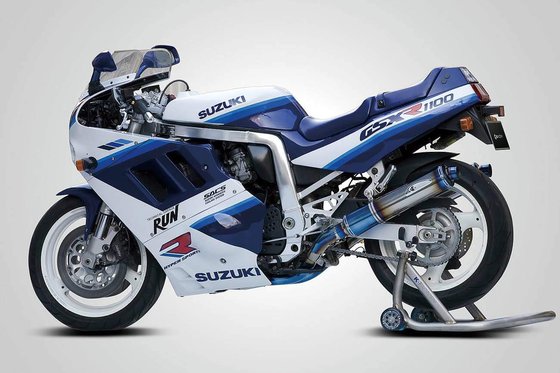
Key Maintenance Tips:
- Valve Adjustments:
- Intake: 0.10–0.15 mm (0.004–0.006 in) cold
- Exhaust: 0.18–0.23 mm (0.007–0.009 in) cold
-
Pro Tip: Use a feeler gauge and torque wrench for precision.
-
Oil Changes:
- Capacity: 4.2L (4.4 qts) with filter (SAE 10W-40)
-
Upgrade Suggestion: Synthetic oils improve cooling for high-RPM runs.
-
Carb Tuning:
- Air screw: 1.75 turns out (1991+ models)
-
Clean jets annually to prevent clogging.
-
Chain Care:
- 114-link chain (15T front/48T rear sprockets)
-
Lubricate every 500 km (310 miles).
-
Brake Fluid:
- Replace DOT 4 fluid every 2 years.
MOTOPARTS.store Recommendations:
- Spark Plugs: NGK DR9EIX Iridium (longer lifespan than stock JR9B)
- Suspension Upgrades: Aftermarket fork cartridges for improved damping
- Exhaust: Slip-on systems reduce weight and amplify the engine’s roar
Conclusion: Why the GSX-R 1100 Still Matters
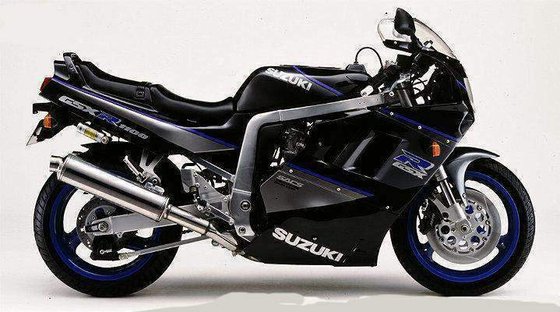
The 1989–1992 Suzuki GSX-R 1100 is a time capsule of an era when “hyperbike” meant unapologetic power and mechanical simplicity. Its air/oil-cooled engine, thunderous exhaust note, and analog thrills stand in stark contrast to today’s electronically sanitized superbikes. For riders seeking a classic that rewards skill and demands respect, the GSX-R 1100 remains a crown jewel of ’90s motorcycling.
Whether you’re restoring one or pushing it through canyon roads, MOTOPARTS.store has the parts to keep this legend roaring—and cornering—like it’s 1991.
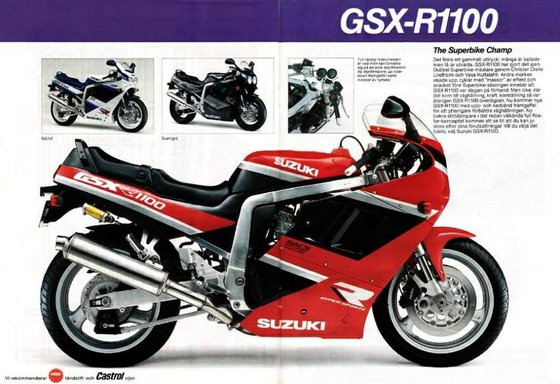


Specifications sheet
| Engine | |
|---|---|
| Stroke: | Four-stroke |
| Max power: | 105 kW | 141.0 hp |
| Max torque: | 117 Nm |
| Fuel system: | 4 x 40 mm Mikuni Flatslide CV carburetors |
| Max power @: | 9500 rpm |
| Displacement: | 1127 ccm |
| Max torque @: | 8000 rpm |
| Bore x stroke: | 78.0 x 59.0 mm (3.1 x 2.3 in) |
| Configuration: | Inline |
| Cooling system: | Air/Oil cooled with two separate oil pumps |
| Compression ratio: | 10.0:1 |
| Number of cylinders: | 4 |
| Valves per cylinder: | 4 |
| Dimensions | |
|---|---|
| Wheelbase: | 1465 mm (57.7 in) |
| Dry weight: | 210 |
| Wet weight: | 240 |
| Seat height: | 810 mm (31.9 in) |
| Overall length: | 2090 mm (82.3 in) |
| Fuel tank capacity: | 21 L (5.5 US gal) |
| Drivetrain | |
|---|---|
| Final drive: | chain |
| Gear Ratios: | 1st 2.38 / 2nd 1.63 / 3rd 1.25 / 4th 1.05 / 5th 0.91:1 |
| Chain length: | 114 |
| Transmission: | 5-speed |
| Rear sprocket: | 48 |
| Front sprocket: | 15 |
| Maintenance | |
|---|---|
| Engine oil: | 10W40 |
| Idle speed: | 1100 ± 100 rpm |
| Brake fluid: | DOT 4 |
| Spark plugs: | NGK JR9B or NGK DR9EIX |
| Spark plug gap: | 0.7 |
| Forks oil capacity: | 0.836 |
| Engine oil capacity: | 4.2 |
| Engine oil change interval: | Every 5000 km or 2 years |
| Valve clearance (intake, cold): | 0.10–0.20 mm |
| Valve clearance check interval: | 24,000 km / 15,000 mi |
| Valve clearance (exhaust, cold): | 0.20–0.30 mm |
| Recommended tire pressure (rear): | 2.5 bar (36 psi) solo, 2.9 bar (42 psi) with passenger |
| Recommended tire pressure (front): | 2.3 bar (33 psi) |
| Chassis and Suspension | |
|---|---|
| Frame: | Aluminum twin-spar |
| Rear tire: | 180/55 z-17 |
| Front tire: | 120/70 z-17 |
| Rear brakes: | Single 240 mm disc, 2-piston caliper |
| Front brakes: | 2 x 310 mm discs, 4-piston calipers |
| Rear suspension: | Monoshock with adjustable preload and damping |
| Front suspension: | 43mm Kayaba telescopic fork, adjustable rebound, compression damping, and preload |



